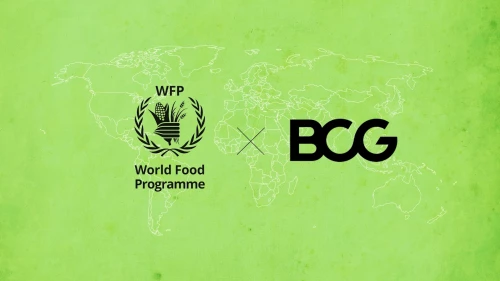For a child, stunting is a cruel fate. Caused by chronic hunger, stunting leads to serious and permanent damage of a child’s brain and body and lowers resistance to disease. In the 50 countries with the highest levels of chronic hunger, more than 30% of the children are affected by stunting, creating problems not only for individual people but also for economies and societies.
But although the challenge of stunting has marshaled the resources of organizations, including government agencies and nongovernmental organizations (NGOs), individual and system complexities make it hard for countries to find solutions for chronic child hunger. To develop a new solution, and to explore how it might help nations to address other severe problems such as a lack of access to health care, BCG worked with the government of Tanzania and the World Food Programme (WFP) to implement BCG’s Smart Simplicity approach.
Rather than create new structures, processes, or systems—which often add complicatedness—we focused on the context, the ways people interact within that context, and what drives their behavior. We also used analytical tools and insights from social sciences to create strategies that promote new behaviors and ways of working. In the process, we found that Smart Simplicity can help countries make progress on complex problems—such as a lack of access to quality education and health services—even in highly challenging social and environmental contexts.
Individual and System Complexities
The first step in applying Smart Simplicity is to analyze the individual and system complexities that hamper solutions despite the existence of well-recognized interventions. (See the exhibit.)
When it comes to the individual complexities driving stunting, the causes might seem surprising: mothers fail to provide children with adequate nutritious food, they neglect to use hygiene practices that prevent diarrhea, or they don’t take malnourished children to the health clinic. However, when analyzing the constraints mothers face in countries where chronic child hunger is prevalent, such behaviors can be understood, enabling those behaviors to be modified.
Mothers may not act because they do not recognize stunting. Malnourished children often appear happy and healthy, whereas those suffering from malaria clearly demand immediate medical attention. Community health workers often record cases of malaria, HIV and AIDS, and tuberculosis, but they rarely track stunting. Local health clinics chart the weight of children but not their height.
Even if mothers understand malnutrition and the need for exclusive breastfeeding (feeding an infant only breast milk) for the first six months, deworming, and proper hygiene, putting these solutions into practice is difficult. Often mothers are juggling childcare with other demands, such as working on the land, fetching water, or collecting firewood. Visiting the health clinic may mean missing a day’s work.
Cultural norms erect obstacles, too. For example, some traditional practices prohibit mothers from eating certain types of food, such as eggs or meat. And as women are generally held responsible for household duties and childcare, as well as working, little time is left to focus on good nutritional practices.
Knowing what to do, when, and how is essential to success. But because of a lack of measurement tools, as well as the absence of a single data set and key indicators—such as the prevalence of stunting—local health workers are unable to tell where chronic hunger is occurring most regularly and where best to focus their efforts. Without feedback loops between mothers and health workers, little is known about whether interventions—such as those that provide food, vitamins, and breastfeeding training—are being deployed and having an impact. Meanwhile, with various groups delivering interventions, it is hard to assess their relative impact and to develop a holistic approach.
System complexities compound these difficulties. Certainly, the resources that government agencies, donors, NGOs, advocacy groups, and others devote to stunting help. But the way their efforts are organized has created complexities that prevent their individual interventions from having a transformative impact.
The battle against stunting requires changes that demand coordinated action rather than isolated efforts.
For example, insufficient interaction between various government agencies—such as ministries of health, nutrition, education, water and sanitation, and agriculture—can slow progress in the battle against stunting. It requires changes in areas such as education, the food supply, and the quality of sanitation services, demanding coordinated action rather than isolated efforts.
A lack of collaboration can have knock-on effects: Governments and development partners do not work with a single data source or shared objectives. Additionally, each organization develops its own processes, procedures, committees, and working groups. The outcome is often splintered and duplicated efforts. This means that simply increasing the volume of inputs—whether time, money, or resources such as nutritious food supplies—does not necessarily produce better results.
In facing these obstacles, those fighting stunting are not alone. The people and organizations working to address other global challenges encounter many of the same issues, including the following:
- Disappointing results, despite many attempts to solve the problem with substantial resources and goodwill
- The lack of an overarching authority with the legitimacy and power needed to influence the many stakeholders
- Many stakeholders (including households, NGO teams, and government officials) making microdecisions that are rational in the context of their individual goals, resources, and constraints but that work against each other in the aggregate, preventing an overall solution from being found
There is something else that global problems share: when they are successfully solved, they improve individual lives and benefit the common good. For example, better-fed, healthier children have better lives and support a country’s human capital and economic development.
Finding out what is working in Tanzania offers insights for stakeholders that are trying to find solutions to chronic hunger and other similarly complex and seemingly intractable problems.
Factors for Success
Despite the obstacles and complexities, chronic child hunger has been successfully reduced in several countries: Brazil, India, Malawi, Mauritania, Peru, Senegal, and Vietnam. Strong parallels exist between the efforts of these countries and the Smart Simplicity approach to managing complexity.
Although progress on nutrition could in some cases be linked to a nation’s economic growth, our analysis found that a number of other factors were responsible for the success of these countries’ efforts. These factors included the availability of good data, a central team focused on reducing hunger that had access to decision makers, strong links and feedback loops among national and local actors, and stakeholders that were empowered to act at every level.
In looking to apply Smart Simplicity to chronic hunger and stunting in Tanzania, BCG’s analysis revealed that a number of the key elements of Smart Simplicity were already in place. These included clear government sponsorship, a committed national integrator, and government-approved targets (such as the country’s goal to reduce stunting from 34% to 28% by 2021). However, the analysis also revealed gaps—such as the lack of a single source of nutrition data and weak district-level stunting data—limiting the insights that could guide decisions.
On the basis of this analysis, BCG chose to work in Tanzania in partnership with the WFP. Together, we adapted Smart Simplicity to support specific government agencies and NGOs that were implementing programs to address chronic hunger. The first step was to conduct a thorough analysis of the ecosystem addressing malnutrition, its strengths and weaknesses, as well as the context in which people and organizations were operating.
The next step was to work with existing stakeholders to identify potential changes that could be made to this ecosystem and context to enable the new individual behaviors and collaborative efforts that could improve overall outcomes. In doing this, we focused on four key areas:
Working with Government. Applying Smart Simplicity to challenges such as stunting means understanding the context in which leaders operate and how that shapes their behaviors. Since local authorities are highly motivated to have a local impact, rather than introducing new structures, much progress can be made working within existing hierarchies, roles, and responsibilities.
In Tanzania, for example, district officers report to district executive directors. DEDs follow the lead of the President’s Office of Regional Administration and Local Government and are accountable to this office for district-level performance on nutrition. Gaining the commitment of the DEDs, therefore, helped to secure local budgets and execute plans.
It can prove to be important for a national government to assign regional and local responsibilities for action on child nutrition and enshrine them in policy documents. This provides transparency and gives legitimacy to nutritional strategies.
Creating Catalyst Teams. One of the biggest obstacles to solving complex problems is the existence of funding models that require NGOs to demonstrate their efficiency to donors—something that becomes difficult when their efforts are combined with those of other organizations. Because the funding model hinders collaboration, it was necessary to change their ways of working so that staff in government agencies and NGOs could together act as an independent catalyst team, creating an approach to allocating funds that was better coordinated and, therefore, more effective.
This team spurs the implementation of interventions by coordinating stakeholders, overseeing pilots, monitoring and reporting progress, and alerting decision makers to potential roadblocks. This team needs to be sufficiently close to implementation operations to assess the impact of collaborative efforts and to encourage further cooperation.
In Tanzania, the catalyst team—embedded within the Tanzania Food and Nutrition Centre, under the Ministry of Health—became the glue at the central and district levels, guiding the efforts of all those working to improve nutrition.
Robust data collection and analysis, as well as the dissemination of findings, are essential to combating complex problems.
Using Data as a Key Tool. Robust data collection and analysis, as well as the dissemination of findings, are essential to combating complex problems. In Tanzania, data collection efforts started with mothers, since knowing a child’s height as well as weight helps them understand stunting. Health facilities, therefore, needed to include height boards among their anthropometric (body measurement) tools.
At the community level, data collection is critical to planning interventions and assessing progress. In Tanzania, the BCG-WFP team helped strengthen data systems, increase access to nutritional information, and train village health officials in how to use this information to educate families. A database of anthropometric tools—the types and their locations in health facilities nationwide—was established to improve intervention targeting.
The catalyst team also plays a key role in making data an important tool. In Tanzania, the team developed a nutrition cockpit, an online hub for the prevention and control of malnutrition. By creating a single website and giving all stakeholders access to information relevant to nutrition—including training programs, official policies, guidelines, bottleneck analysis, and an events calendar—the team advanced data collection and analysis and facilitated collaboration and data-driven decision making. In addition, as the single source of nutrition data, the nutrition cockpit helped meet the transparency demands of the government, donors, and implementation partners.
Training Stakeholders. Key to addressing chronic hunger is training. In Tanzania, this started in the home. Weekly radio broadcasts focused on nutrition and signs of stunting, which created awareness among mothers of the dangers of stunting, prompted them to have their children measured, and encouraged them to seek solutions, if needed. Training religious leaders to discuss stunting with families, as well as with couples before they married, also built awareness.
Meanwhile, training stakeholders to collaborate is essential. In Tanzania, the catalyst team developed and delivered a training program in nutrition collaboration. Using video, demonstrations, and other forms of instruction, team members helped stakeholders adopt collaboration practices, such as participating in feedback loops, celebrating what is working, and acknowledging what isn’t. Rather than simply providing additional technical skills, the training program empowered people to work in completely different ways.
To ensure that a catalyst team’s training programs lead to material change, intensive support and follow up is essential. In Tanzania, at the end of each training program, the team asked participants—whether from the health, education, or agriculture sectors—to make commitments, such as to communicate more frequently with their ministry counterparts. After the training has been completed, the team should check in monthly on these commitments.
The Next Steps for Tanzania
In Tanzania, the Smart Simplicity approach has the potential for significant impact. Although the development of data collection systems requires more work, major advances have been made on improving collaboration, particularly at the district level, and the Tanzanian government, supported by the WFP, is moving toward achieving a reduction in stunting. To ensure that the government accomplishes its goal, the Smart Simplicity steering committee—which includes government and WFP representatives—has set out the next steps to be taken.
Some steps are focused on data. For example, the steering committee is seeking to provide anthropometric tools to all health facilities, train the health staff, and ensure that data systems enable wide access to nutritional information. To understand what stakeholders value, the committee is fostering the creation of feedback loops at all levels—national, regional, district, and village.
Encouraging greater collaboration is a key goal. The committee recommends uniting cross-sector stakeholders—including government agencies, NGOs, and businesses—on a common goal and holding them jointly accountable. Expanding the catalyst team model is also critical, and the committee’s recommendations include establishing a catalyst team to implement initiatives locally, without disrupting existing structures, systems, and hierarchies. The central catalyst team will continue to drive forward initiatives on behalf of the government, agencies, and others, and to act as the central coordinating team for the implementation of all national nutrition efforts.
Lessons from Tackling Child Hunger
The application of Smart Simplicity to chronic child hunger in Tanzania showed how this analytical approach is relevant for any organization or group of stakeholders trying to address a long-term, complex problem, such as poverty or poor access to education and health services. Specific lessons include the following:
- Successful interventions are not based on persuasion or nudging but on social sciences, which can guide data collection, problem analysis, and solution design.
- Instead of judging the efforts of individual people as failures or mistakes, those trying to address complex problems should identify the context that leads people toward certain behaviors. Changing that context prompts shifts in behaviors, both individually and in the aggregate, allowing governments, NGOs, and other organizations to be informed by facts before implementing interventions.
- Rather than applying a preexisting package of solutions, using analytical tools makes it possible to find a way for all stakeholders to work effectively together to develop solutions that are more likely to succeed in the local context.
- Working with existing stakeholders and within an existing context—however complex—makes it possible to harness existing skills and resources.
- An integrator that is close to implementation operations—in this case, the catalyst team—fosters collaboration by observing and assessing collective efforts and the results.
- The integrator should manage feedback at the implementation level and communicate with all stakeholders involved.
This approach is particularly helpful at a time when development resources are stretched and competition for donor funding is intensifying. Although accessing new sources of funding and resources will always be important, Smart Simplicity can enable governments to address a problem using current resources.
Rather than adding new pieces to the puzzle, Smart Simplicity enables the existing pieces to fit better together, amplifying the impact made by everyone involved and greatly increasing the chances of solving even the most complex challenges.
This article summarizes “Using Smart Simplicity to Tackle Complex Global Challenges: Chronic Child Hunger in Tanzania,” which was published in Social Business, a journal that focuses on the elimination of poverty and the enhancement of human welfare and that aims to provide a forum for the exchange of ideas and experiences among academics and practitioners working toward this goal.








